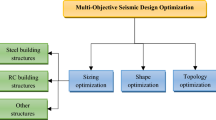Abstract
Conventional seismic passive pressures of earth structures are based on a linear failure criterion in earthquake zones. However, experimental evidence shows that the strength envelopes are nonlinear over a wide range of normal stresses. In this paper, the analytical expressions of seismic passive pressures acting on inclined rigid walls are derived with nonlinear failure criterion. Quasi-static representation of earthquake effects using a seismic coefficient is adopted for seismic estimations. Instead of using the nonlinear criterion, a linear failure criterion, which is tangential to the nonlinear criterion, is used to formulate the seismic passive pressure problems as nonlinear programming problems. Analytical results are presented and compared with the previously published solutions using numerical technique. The influences of the parameters in the nonlinear failure criterion on seismic pressures and failure mechanisms are discussed.
Similar content being viewed by others
References
Chen W.F.: Limit Analysis and Soil Plasticity. Elsevier Science, Amsterdam (1975)
Yang X.L., Yin J.H.: Estimation of seismic passive earth pressure with nonlinear failure criterion. Eng. Struct. 28(3), 342–348 (2006)
Soubra A.H., Macuh B.: Active and passive earth pressure coefficients by a kinematical approach. Proc. Inst. Civil Eng. Geotech. Eng. 55(2), 119–131 (2002)
Okamoto, S.: Bearing capacity of sandy soil and lateral earth pressure during earthquake. In: Proceeding of the 1st World Conference on Earthquake Engineering, CA, pp. 1–26 (1956)
Budhu M., Al–Karni A.: Seismic bearing capacity of soils. Geotechque 43(4), 181–187 (1993)
Paolucci R., Pecker A.: Seismic bearing capacity of shallow strip foundation on the dry soils. Soils Found. 37(3), 95–105 (1997)
Richards R., Elms D., Budhu M.: Seismic bearing capacity and settlement of foundations. J. Geotech. Geoenviron. Eng. ASCE 119(4), 662–674 (1993)
Agar J.G., Morgenstern N.R., Scott J.: Shear strength and stress–strain behavior of Athabasca oil sand at elevated temperatures and pressure. Can. Geotech. J. 24(1), 1–10 (1985)
Baker R.: Nonlinear Mohr envelopes based on triaxial data. J. Geotech. Geoenviron. Eng. ASCE 130(5), 498–506 (2004)
Cai M., Kaiser P.K., Tasaka Y., Minami M.: Determination of residual strength of jointed rock masses using the GSI system. Int. J. Rock Mech. min. Sci. 44(2), 247–265 (2007)
Goodman R.E.: Introduction to Rock Mechanics. 2nd edn. Wiley, London (1989)
Kennedy T.C., Lindberg H.E.: Tunnel closure for nonlinear Mohr Coulomb functions. ASCE J. Eng. Mech. Div. 104(EM6), 1313–1326 (1978)
Lefebvre G.: Strength and slope stability in Canadian soft clay deposits. Can. Geotech. J. 18(3), 420–442 (1981)
Maksimovic M.: Nonlinear failure envelope for soils. J. Geotech. Eng. ASCE 115(4), 581–586 (1989)
Mello V.B.F.: Reflections on design decisions of practical significance to embankment dams-17th Rankine Lecture. Geotechnique 27(3), 281–354 (1997)
Perry J.: A technique for defining nonlinear shear strength envelopes and their incorporation in a slope stability method of analysis. Quart. J. Eng. Geol. 27(3), 231–241 (1994)
Zhang X.J., Chen W.F.: Stability analysis of slopes with general nonlinear failure criterion. Int. J. Numer. Anal. Methods Geomech. 11, 33–50 (1987)
Lysmer J.: Limit analysis of plane problems in soil mechanics. J. Soil Mech. Found. Div. ASCE 96, 1311–1334 (1970)
Donald I.B., Chen Z.Y.: Slope stability analysis by the upper bound approach: fundamental and method. Can. Geotech. J. 34(6), 853–862 (1997)
Yu H.S., Salgado R., Sloan S.W.: Limit analysis versus limit equilibrium for slope stability. J. Geotech. Geoenviron. Eng. 124(3), 265–276 (1998)
Baker R., Frydman S.: Upper bound limit analysis of soil with nonlinear failure criterion. Soil Found. 23(4), 34–42 (1983)
Author information
Authors and Affiliations
Corresponding author
Rights and permissions
About this article
Cite this article
Yang, XL. Seismic passive pressures of earth structures by nonlinear optimization. Arch Appl Mech 81, 1195–1202 (2011). https://doi.org/10.1007/s00419-010-0478-8
Received:
Accepted:
Published:
Issue Date:
DOI: https://doi.org/10.1007/s00419-010-0478-8




